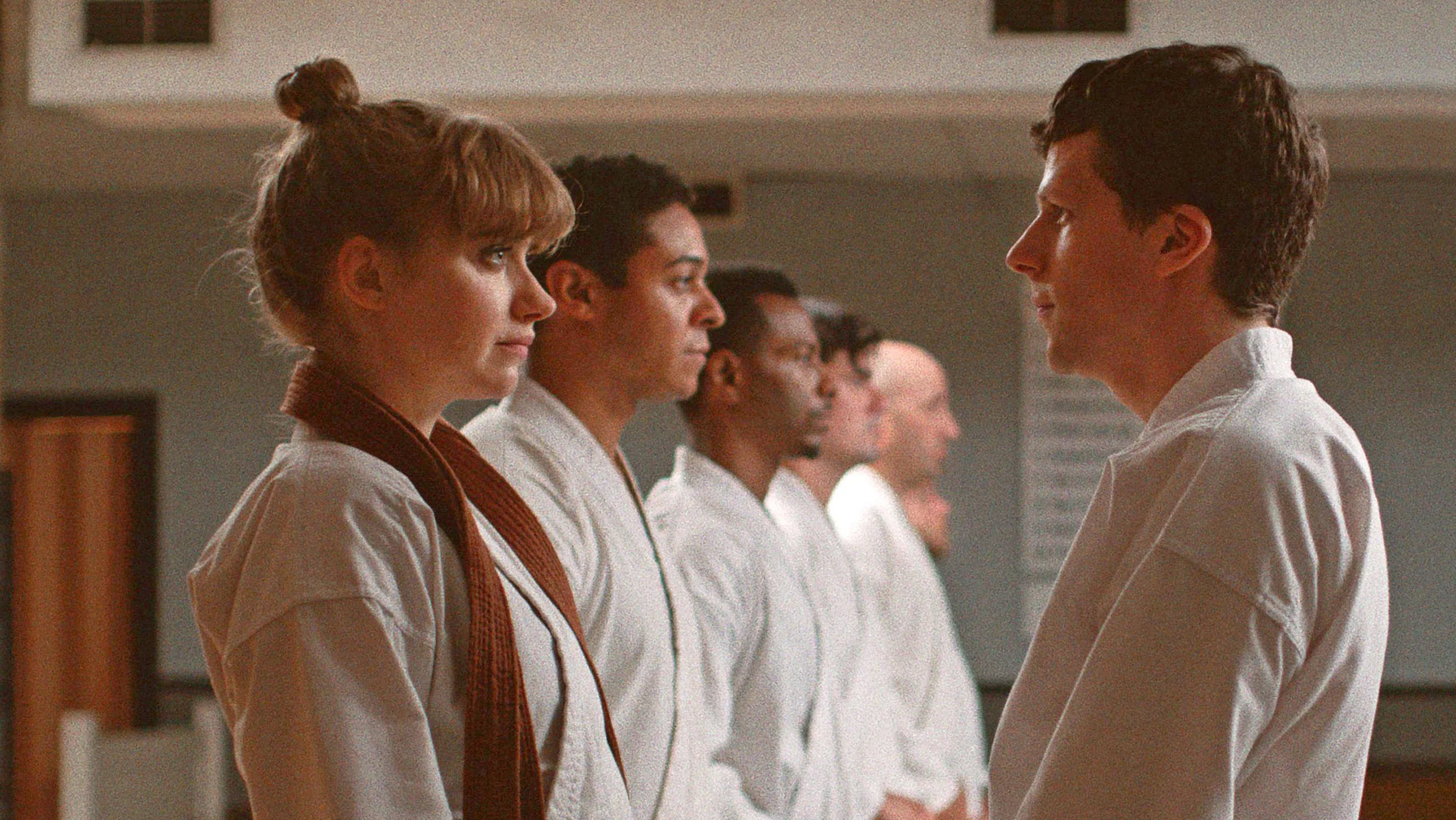A Kick to the Teeth: 'The Art of Self-Defense’ Film Review
by Will Lindus
A subversive black comedy that intentionally leans into the trappings of toxic masculinity, The Art of Self-Defense is a visceral kick (with a fist) to the teeth. Casey (Jesse Einsenberg) is a put-upon accountant who finds himself relentlessly teased and bullied by the more aggressive men in his office and by the people he encounters in his day-to-day life. After being ruthlessly attacked by a group of bikers one evening, Jesse finds himself hospitalized and afraid - more afraid than ever. The world frightens him, and in a moment of desperation, he signs up for karate lessons at a local dojo so that he can learn to become as tough as the things that he fears. It is there that he is taken under the wing of a hyper-masculine, assertive, and charismatic Sensei (Alessandro Nivola), who promises to change Casey’s life.
To put it lightly, The Art of Self-Defense doesn’t pull any of its punches. The humor exists mostly in the deadpan line deliveries and matter-of-fact statements made by characters as they respond to the blunt absurdities of their world. Characters say what they mean, even if they don’t always mean what they say, and the reactions to these direct outpourings that pepper every single conversation of the film are consistently hilarious. For every laugh, though, there’s a cringe; the violence in The Art of Self-Defense is intense and bone-crunching, a term I use not for hyperbolic description but as a literal representation of the bones that crunch and the blood that pours as the film escalates. This isn’t to say that the violence is gratuitous; no, it is judiciously used to underline the absurdity, the terror, or the thematic significance of a given situation. But when it does appear? You’ll squirm in your seat. At least, I did.
Jesse Eisenberg is the best we’ve seen him in some time in the role of Casey. For a while, Eisenberg has been cast in roles that rely more on his talent with being smarmy than with his ability to sincerely play vulnerability. Here, both traits come clearly to the surface. Casey is a fragile, timid man, who latches on to the most toxic form of masculinity possible - violence as power - and wields it as a weapon against those who would make him feel small. Casey is, at the same time, a victim and a beneficiary of the more volatile and corrosive elements of the hyper-masculine world that he steps into. He is sympathetic on the surface, but his willingness to accept the social power that comes along with his descent into toxic masculinity, even if it exists within the small sphere of influence of the dojo, makes Casey just as culpable as the most meat-headed ‘alpha male.’
This - more so than even the humor, the violence, or the performances - is what makes The Art of Self-Defense so stunning. This is a film that embodies the negative societal aspects that it condemns, and not subtly. Texas-based writer and filmmaker Riley Stearns showcases his razor sharp scriptwriting prowess here, for sure, but it is in the execution that the film soars. For a filmmaker only on his second feature (the first being the criminally underrated cult deprogramming dramedy Faults), Stearns demonstrates a firm understanding of the thematic elements of his pieces, and most importantly, how to bring every element of his film in concert to support these themes. As someone who sees a ton of movies, this kind of harmony is rather refreshing.
Of course, focusing only on Casey undersells a pair of dynamo performances in the Sensei (Alessandro Nivola) and Anna (Imogen Poots). Both are corrupted by the false sense of promise offered by the dojo; Sensei is an idealized version of what Casey wants to achieve, and this works only because Nivola exudes raw charisma with every line and every movement. Anna, on the other hand, is the direct victim of the specific brand of toxic masculinity that exists within the Sensei’s world. Anna is often the most capable person in the room, able to blend compassion with steely resolve, able to kick the ass of anyone who squares off against her. But her gender holds her back, at least, within the societal constructs forced upon her. Casey, Sensei, and Anna are on three different corners of the power dynamic at play, each impacted by their roles, the expectations of their roles, and the expectations on how they are supposed to respond to each other.
Bottom Line: The Art of Self-Defense is not subtle with its metaphor, and it isn’t exactly saying anything new. However, the fact remains that toxic masculinity exists as a driving force in our world, and I’ll keep watching as many movies as get made about it until we learn how to be better. In this case, though, it isn’t just the messaging that is endearing, but in the delivery. The Art of Self-Defense will make you squirm, it will make you laugh, and hopefully, it will make you examine the more negative behaviors in your life.
4.5 out of 5 Bear Paws


